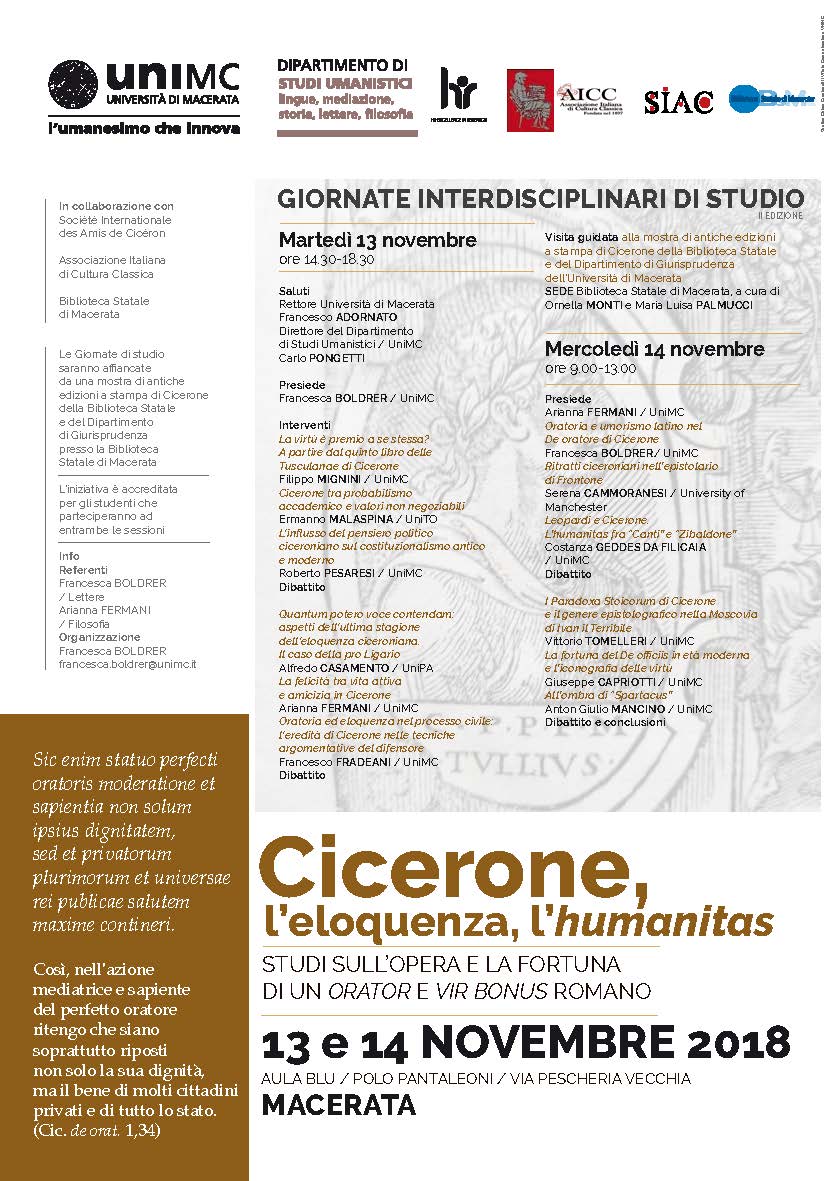Ritratti ciceroniani nell’epistolario di Frontone - Ciceronian Portraits in Fronto's Letters
DOI:
https://doi.org/10.13135/2532-5353/4128Abstract
Riassunto Nella corrispondenza con Marco Aurelio, Frontone fonda la sua auctoritas
allo stesso tempo sul suo ruolo di maestro e sull’associazione con i suoi modelli
retorici e letterari, fra i quali troviamo Cicerone. Sebbene l’arcaismo di Frontone
sembri in contrasto con l’ammirazione per l’Arpinate, quest’ultimo viene presentato
come modello di epistolografia ed oratoria. La canonizzazione e i meccanismi
di appropriazione dell’“icona-Cicerone” da parte di autori del primo secolo d.C.,
delineata da Robert A. Kaster nel 1988, offrono un adeguato termine di paragone
per lo studio della corrispondenza frontoniana. Frontone si accosta a Cicerone, il
quale è esclusivamente menzionato in relazione alla sua capacità oratoria e alla
sua abilità di epistolografo, in maniera agonistica e con intenti parenetici. Presentando
l’epistola familiare come “ciceroniana” e amplificando le possibilità didattiche
di tale genere, Frontone legittima la sua scelta della lettera privata come mezzo
didattico privilegiato. In tale contesto epistolare, le orazioni ciceroniane costituiscono
il punto di partenza delle lezioni di retorica del Cirtense (si veda
l’impiego della Pro Caelio) o exempla per l’imperatore (come nel caso della Pro lege
Manilia). Lo scopo è quello di fare di Marco Aurelio il suo “imperatore ideale”,
la cui autorità è basata sull’eloquentia, espressione di virtus. Infine, Frontone stesso
prende il posto di Cicerone come exemplum per il suo discepolo.
Abstract In his correspondence with Marcus Aurelius, Fronto draws his auctoritas
simultaneously from his role as tutor and from identifying with select rhetorical
and literary models, among whom Cicero stands out. While Fronto’s archaism
would appear to be in contrast with his admiration for Cicero, the latter is
praised as paradigm for epistolography and oratory. The canonisation of Cicero
and the mechanism of appropriation of this “icon” by first-century authors, already
outlined by Robert Kaster (1998), offer a suitable framework for the study
of Fronto’s correspondence. Fronto’s approach to Cicero, who is exclusively mentioned
in relation to his oratorical ability and his exceptional letter-writing, is
both agonistic and functional to his didactic aims. By framing the letter to familiares
as “Ciceronian” and emphasising this epistolary sub-genre’s didactic elements,
Fronto legitimises the use of private letter as a didactic medium. In this
epistolary context, Cicero’s speeches function either as a starting point for Fronto’s
own lessons on rhetoric (cf. his use of the Pro Caelio) or as exempla for the
emperor (this is the case of the Pro lege Manilia), with the purpose of turning him
into the “ideal Emperor”, who grounds his authority in eloquentia, as an expression
of virtus. Ultimately, Fronto himself replaces the Ciceronian model as exemplum
for his pupil.
Downloads
Downloads
Published
How to Cite
License
Authors who publish with this journal agree to the following terms:
- Authors retain copyright and grant the journal right of first publication with the work simultaneously licensed under a Creative Commons Attribution License that allows others to share the work with an acknowledgement of the work's authorship and initial publication in this journal.
- Authors are able to enter into separate, additional contractual arrangements for the non-exclusive distribution of the journal's published version of the work (e.g., post it to an institutional repository or publish it in a book), with an acknowledgement of its initial publication in this journal.


 Ciceroniana On Line is recognised by ANVUR (the National Agency for the Evaluation of the University System and Research) as a CLASS A journal for the Sciences of Antiquity, Philology, Literature and History of Art (
Ciceroniana On Line is recognised by ANVUR (the National Agency for the Evaluation of the University System and Research) as a CLASS A journal for the Sciences of Antiquity, Philology, Literature and History of Art ( The journal is included in DOAJ. The DOAJ listing of the journals is available at
The journal is included in DOAJ. The DOAJ listing of the journals is available at  The journal is indexed in
The journal is indexed in  The journal has been included in ERIH PLUS. The ERIH PLUS listing of the journals is available at
The journal has been included in ERIH PLUS. The ERIH PLUS listing of the journals is available at 

